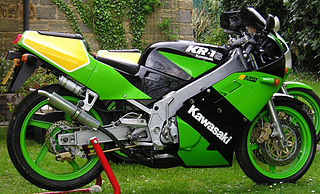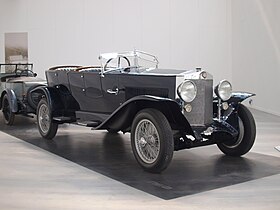
Toyota Motor Corporation's M family of engines were a longitudinally mounted straight-6 engine design. They were used from the 1960s through the 1990s. All M family engines were OHC designs. While the M family was born with a chain-driven single camshaft it evolved into a belt-driven DOHC system after 1980. All M family engines used a cast-iron block with an aluminum cylinder head, and were built at the Toyota Kamigo plant in Toyota City, Japan.
The Ferrari Dino engine is a line of mechanically similar V6 and V8 engines produced by Ferrari for about 40 years from the late 1950s into the early 2000s.

The Ferrari Colombo Engine was a petrol fueled, water cooled, carburetted 60° V12 engine designed by Gioacchino Colombo and produced in numerous iterations by Italian automaker Ferrari between 1947 and 1988. The maker's first homegrown engine, its linear successor is the Lampredi V12, which it far outlived, the last Lampredi being made in 1959.

The Mitsubishi 4G9 engine is a series of straight-4 automobile engines produced by Mitsubishi Motors. All are 16-valve, and use both single- and double- overhead camshaft heads. Some feature MIVEC variable valve timing, and it was the first modern gasoline direct injection engine upon its introduction in August 1996.

The Lamborghini V10 is a ninety degree (90°) V10 petrol engine which was developed for the Lamborghini Gallardo automobile, first sold in 2003.

The Lamborghini V8 is a ninety degree (90°) V8 petrol engine designed by Lamborghini in the 1970s for their less-expensive vehicles. It was only the second internal combustion engine ever developed by the company, and first saw production for the 1971 Lamborghini Urraco. It was designed by Giampaolo Dallara. The all-aluminium alloy engine was introduced as a 2.5-litre variant, displacing 2,463 cc (150.3 cu in), but was expanded, by increasing the piston stroke to a 3.0-litre variant for 1975 - now displacing 2,997 cc (182.9 cu in).

The E-series was a line of inline four-cylinder automobile engines designed and built by Honda for use in their cars in the 1970s and 1980s. These engines were notable for the use of CVCC technology, introduced in the ED1 engine in the 1975 Civic, which met 1970s emissions standards without using a catalytic converter.

The Austin Motor Company A-series is a British small straight-4 automobile engine. Launched in 1951 with the Austin A30, production lasted until 2000 in the Mini. It used a cast-iron block and cylinder head, and a steel crankshaft with three main bearings. The camshaft ran in the cylinder block, driven by a single-row chain for most applications, and with tappets sliding in the block, accessible through pressed steel side covers for most applications, and with overhead valves operated through rockers. The cylinder blocks are not interchangeable between versions intended for conventional end-on mounted gearboxes and the 'in-sump' transaxle used on British Motor Corporation/British Leyland front wheel drive models such as the Mini. The cylinder head for the overhead-valve version of the A-series engine was designed by Harry Weslake – a cylinder head specialist famed for his involvement in SS (Jaguar) engines and several Formula One-title winning engines. Although a "clean sheet" design, the A-series owed much to established Austin engine design practise, resembling in general design and overall appearance a scaled-down version of the 1200cc overhead-valve engine first seen in the Austin A40 Devon which would form the basis of the later B-series engine.

The Prince G-series engine was the company's only straight-four and straight-six engines which began production in 1955. A number of variations were made, with both OHV and OHC heads. A diesel four-cylinder with 1.9 L (1,862 cc) was also built, called the D-6. The G series was used in the Skyline, the Laurel, and the Gloria from the 1950s to the early 1970s.

The MA is a straight-4 SOHC 0.9 L, 1.0 L, or 1.2 L engine first introduced in 1982 by Nissan, intended primarily for the K10 series Micra/March model. It shares design similarities with the older E engine, with an 8-valve hemispherical cylinder head but differs in that it uses an aluminium cylinder block. Unusually, the specified ignition timing for the MA10 running on the specified 90 RON gasoline was 2 degrees after top dead centre, reflecting a very high flame speed in the compact combustion chambers.

The Suzuki M engine family is a line of automobile engines from Suzuki. Ranging in displacement from 1.3 L to 1.8 L, it is a modern engine line with dual overhead cams, 16 valves, and multi-point fuel injection (MPFI).

The EA827 family of petrol engines was initially developed by Audi under Ludwig Kraus leadership and introduced in 1972 by the B1-series Audi 80, and went on to power many Volkswagen Group models. This is a very robust water-cooled engine configuration for four- up to eight- cylinders. In Brazil this engine was produced under the name Volkswagen AP AP.

The Kawasaki KR-1 and KR-1S are road-orientated 249 cc (15.2 cu in) two-stroke sports bikes introduced between 1988 and 1992 by Kawasaki Heavy Industries.
The Ferrari flat-12 engine family is a series of flat-12 DOHC petrol engines produced by Ferrari from 1964 to 1996. The first racing Ferrari flat-12, the Mauro Forghieri-designed Tipo 207, was introduced in the Ferrari 1512 F1 car in 1964. Later flat-12 racing engines were used in Ferrari Formula One and sports racing cars from 1968 until 1980, including the 212 E Montagna, 312 B series, 312 PB and 312 T series. The roadgoing flat-12 engines were introduced with the 365 GT4 BB and were produced in various versions until the end of F512M production in 1996.

The Volkswagen-Audi V8 engine family is a series of mechanically similar, gasoline-powered and diesel-powered, V-8, internal combustion piston engines, developed and produced by the Volkswagen Group, in partnership with Audi, since 1988. They have been used in various Volkswagen Group models, and by numerous Volkswagen-owned companies. The first spark-ignition gasoline V-8 engine configuration was used in the 1988 Audi V8 model; and the first compression-ignition diesel V8 engine configuration was used in the 1999 Audi A8 3.3 TDI Quattro. The V8 gasoline and diesel engines have been used in most Audi, Volkswagen, Porsche, Bentley, and Lamborghini models ever since. The larger-displacement diesel V8 engine configuration has also been used in various Scania commercial vehicles; such as in trucks, buses, and marine (boat) applications.

















